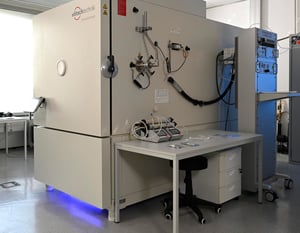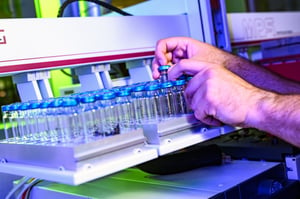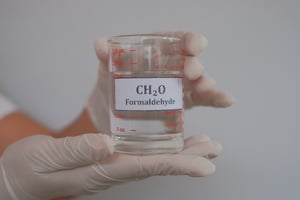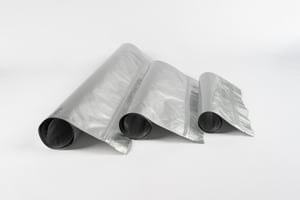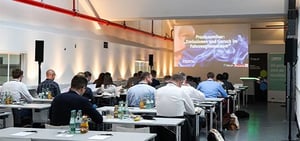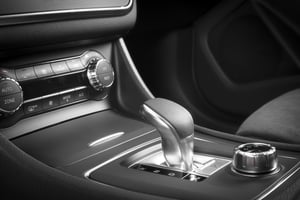
Fogging
Determination of the fogging behavior of materials used in vehicle interiors
FOGGING TEST IN THE
AUTOMOBILE INTERIOR
PRECISE TESTING FOR LONG-LASTING QUALITY
The color fastness of textile and leather surfaces in vehicle interiors is a decisive factor for the quality and durability of a vehicle. OEMs and suppliers are faced with the challenge of developing materials that are both aesthetically pleasing and resistant to the effects of light and UV radiation. As an innovative testing service provider, we support you in the validation of your products through precise and standard-compliant testing.
Our laboratories carry out standardized light fastness tests in accordance with international standards such as ISO 105-B06, DIN EN ISO 4892 and SAE J2412. The materials are exposed to intensive light and UV radiation to evaluate their color stability. Using state-of-the-art xenon arc testing equipment, we simulate the long-term influence of sunlight on your materials. The results provide you with reliable data on light fastness and enable you to make any necessary adjustments at an early stage.

Fogging
test methods
- BMW Group: DIN 75201
- Mercedes-Benz (formerly Daimler): DIN 75201
- Fiat Chrysler Automobiles: SAE J 1756
- Ford: SAE J 1756
- General Motors: GMW 3235
- Jaguar / Land Rover: SAE J 1756
- Porsche: DIN 75201
- Volkswagen Group: PV 3015
- Volvo: VCS 1027,2719
- Toyota: TSM 0503 G
- Renault: D45 1725
- PSA (Peugeot / Citroën): D45 1725
- and many more.
Fogging test methods
- DIN 75201-A (reflectrometric)
- DIN 75201-B (gravimetric)
- PV 3015 (Volkswagen)
- GMW 3235-A (General Motors Worldwide)
- PSA D45 1727
- and much more.
PRECISE TESTING FOR LONG-LASTING QUALITY
The color fastness of textile and leather surfaces in vehicle interiors is a decisive factor for the quality and durability of a vehicle. OEMs and suppliers are faced with the challenge of developing materials that are both aesthetically pleasing and resistant to the effects of light and UV radiation. As an innovative testing service provider, we support you in the validation of your products through precise and standard-compliant testing.
Our laboratories carry out standardized light fastness tests in accordance with international standards such as ISO 105-B06, DIN EN ISO 4892 and SAE J2412. The materials are exposed to intensive light and UV radiation to evaluate their color stability. Using state-of-the-art xenon arc testing equipment, we simulate the long-term influence of sunlight on your materials.The results provide you with reliable data on light fastness and enable you to make any necessary adjustments at an early stage.
Are you looking for an exam? Standard? Specifications?
Accredited & certified tests
CONTACT OUR EXPERTS
Description. Lorem ipsum dolor sit amet, consetetur sadipscing elitr, sed diam nonumy eirmod tempor invidunt ut labore et
- Tab Title






Importance of color fastness tests for vehicle interiors
Vehicle interiors are exposed to intense sunlight, especially in regions with high temperatures and strong UV exposure. Textiles and leather tend to fade when exposed to light, which not only affects the visual perception of the vehicle, but can also lead to potential complaints from end customers. It is therefore essential to test the color fastness of your materials in a controlled environment before they go into series production.
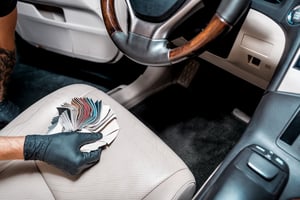
Frequently asked questions about the fogging test
The sample quantities required for a fogging test depend on the standard and the test method used. Here are the general guidelines:
1. standard DIN 75201 (type A and type B)
-
Type A (glass plate method):
A sample quantity of 10 cm² is typically required. The sample is placed on a heated plate in a sealed chamber and the volatiles released condense on a glass plate above. -
Type B (aluminum foil method):
Similar to type A, a sample volume of approximately 10 cm² is used. However, the volatile substances condense on a cooled aluminum foil.
2. standard ISO 6452 (international standard)
- Sample quantity:
Again, a sample size of about 10 cm² is typically required to evaluate the amount of volatiles released at elevated temperature.
3. other specific requirements
Depending on the specific requirements of the customer or OEM standards, sample quantities may vary. It is important to check the respective standards or test requirements carefully.
Method A - Reflectometric method:
- Principle: This method measures the change in reflectivity on a glass plate on which volatile components from the material sample are deposited.
- Procedure: A material sample is heated in a beaker while a glass plate above it is cooled to 21°C. The temperature difference causes the volatile components to condense on the glass plate. The reflectance index of the fogged glass plate is then measured to determine the amount of condensed material.
- Application: This method is particularly suitable for materials for which an exact determination of the optical fog effect is required.
Method B - Gravimetric method:
- Principle: This method measures the weight of condensed volatiles on an aluminum foil.
- Procedure: The material sample is heated in a beaker while an aluminum foil disc is cooled to 21°C. After 16 hours, the amount of condensed material on the foil is weighed.
- Application: This method is ideal for an accurate quantitative determination of the amount of condensed volatiles.
CONTACT US
EMISSIONS & ODOR
Formaldehyd in Fahrzeugen: Herausforderungen für die Automobilindustrie
Read moreStellantis: Freigabe für Emissionsprüfungen erfolgreich (VIAQ)
Read moreVDA 277 vs. VDA 278: Was ist der Unterschied?
Read moreGeruchsunterschiede bei Polypropylen: Die Rolle von Faserverstärkung und Verarbeitungsparametern
Read moreWarum sind die Einheiten der Ergebnisse von Prüfungen der Werkstoffemissionen eigentlich so unterschiedlich?
Read moreGrenzwerte für Formaldehyd und Formaldehydabspaltern in Fahrzeugen
Read moreFREQUENTLY ASKED QUESTIONS ABOUT COLOR FASTNESS
- Avoidance of complaints: By validating color consistency early on, you reduce the risk of quality problems and costly rework.
- Optimal material selection: The test results help you to select the best materials for the vehicle interior.
- Fast response times: Thanks to our efficient testing processes, we offer you short testing times and fast results.


